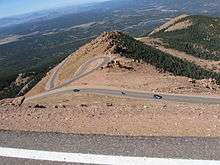Pikes Peak Highway




The Pikes Peak Highway is a 19-mile (31 km) toll road that runs from Cascade, Colorado to the summit of Pikes Peak in El Paso County, at an altitude of 14,115 feet (4,302 m).[1] It is at least partially open year-round, "weather permitting", i.e. open up to the altitude where snow removal becomes excessively difficult.
Highway
The Pikes Peak Highway was constructed in 1915 and financed by Spencer Penrose at a cost of $500,000.[2]
An earlier road up the mountain, the Pike's Peak Carriage Road, dates back to 1888. Thousands of tourists traveled along the Pikes Peak Carriage Road up to Pikes Peak's summit. It was opened by the Cascade Town Company in 1888 and closed in 1902.[3]
Maintenance
Today, the road is maintained by the city of Colorado Springs.
Races
The highway has been home to an annual automobile and motorcycle race called the Pikes Peak International Hillclimb since 1916.[4]
Another race is the Pikes Peak Cycling Hill Climb, first held in 2010.[5] The 2016 edition will also be the first edition of the USA Cycling Hill Climb National Championship.
Environmental damage claim
Litigation was pursued by the Sierra Club in 1998-1999, on grounds of environmental damage from the gravel portion of the road.[6] The environmental damage was caused primarily by the 150,000,000 pounds (70,000 t) of gravel that washes away annually. The same amount needed to be hauled up the mountain each year in order to maintain the road surface. Environmental damage includes alpine ponds and wetlands becoming filled with gravel, and layers of gravel averaging 2 feet (0.6 m) to 4 feet (1.2 m) feet deep covering the forest floor below.[7] Pursuant to the settlement agreed by the Sierra Club and the City of Colorado Springs, the unpaved portion of the Pikes Peak Highway became a hard-surface road, despite concerns that such a project would radically change the nature of the annual automobile and motorcycle race. The paving project was completed on October 1, 2011.[8]
Pikes Peak Hillclimb champion Rod Millen warned that paving the road would put an end to the race.[9] However, the race went ahead normally in 2012 and has continued ever since.
See also
References
- ↑ "NGS Data Sheet for Pikes Peak". National Geodetic Survey.
- ↑ City of Colorado Springs (2002). "History tand Geography of Pikes Peak". Archived from the original on 2006-12-09. Retrieved 2007-02-12.
- ↑ Jeanne Davant (June 5, 2001). "Railroad gets Ute Pass on track/ Mountain land turned into summer havens". The Gazette. Colorado Springs, CO.
- ↑ Overview. Pikes Peak International Hill Climb. Retrieved May 14, 2013.
- ↑ Pikes Peak Cycling Hill Climb. Summit Cycling Productions. Retrieved May 14, 2013.
- ↑ Matthew E. Salek (2006). M.E.Salek "Pikes Peak Toll Road" Check
|url=value (help). Retrieved 2007-02-25. - ↑ James Brooke (1998-10-11). "Car Racers Fight for Gravel on Pikes Peak Road". The New York Times.
- ↑ Rappold, R. Scott (1 October 2011). "Paving completed on Pike`s Peak road, 13 years after Sierra Club suit". Denver Post. Retrieved 17 June 2012.
- ↑ http://www.westword.com/content/printVersion/210371/
External links
- Official website by the City of Colorado Springs
- The Pikes Peak Web site
- M.E.Salek "Roads of Colorado"
Coordinates: 38°54′30″N 104°58′55″W / 38.90822°N 104.98203°W